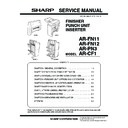Sharp AR-F12 (serv.man6) Service Manual ▷ View online
2-55
CHAPTER 2 FINISHER UNIT BASIC OPERATION
7.
Stapling Tray Sensor Stationary Jam
The sheet does not move past the stapling tray sensor 1 sec after the delivery motor (M2) turned
on.
Jam check
1 sec
1 sec
Stapling tray
sensor (PI4)
sensor (PI4)
Normal
Delivery motor (M2)
Jam check
Stapling tray
sensor (PI4)
sensor (PI4)
Delivery motor (M2)
Jam
Figure 2-264
8.
Timing Jam
The inlet sensor (PI1) detects a sheet before the delivery signal is received from the host machine.
9.
Staple Jam
When the staple motor (M6) is rotating clockwise, the staple home position sensor (PI22) does
not turn on within 0.5 sec. after it has turned off. However, the sensor turns on within 0.5 sec. after the
motor has been rotated counterclockwise.
motor has been rotated counterclockwise.
10. Power-On Jam
One of the inlet sensor (PI1), delivery sensor (PI3), buffer path paper sensor (PI4) or buffer path
inlet paper sensor (PI17) detects paper at power-on.
11. Door Open Jam
One of the joint sensor (PI15), door open sensor (PI16) or door switches (MS1) detects the cover
open during operation (including front door switch (MS2P) when the optional puncher unit is mounted).
12. Punch Jam
The punch home sensor (PI3P) does not turn on again within 200 msec after turning off.
13. Stay Jam Caused By Finisher Start Signal OFF
The finisher start signal is turned OFF in the host machine while paper is being fed in the finisher.
2-56
CHAPTER 2 FINISHER UNIT BASIC OPERATION
III. POWER SUPPLY SYSTEM
1.
Outline
The finisher controller PCB is supplied with 24 VDC power (and 5 VDC power) when the host
machine is turned on. 24 VDC one is used to drive the motor solenoids, while 5 VDC is used for
sensors and ICs on PCBs. Both lines are also used to feed power from the finisher controller PCB to
the saddle stitch controller PCB. Power is also supplied to the punch driver PCB when the optional
puncher unit is mounted.
sensors and ICs on PCBs. Both lines are also used to feed power from the finisher controller PCB to
the saddle stitch controller PCB. Power is also supplied to the punch driver PCB when the optional
puncher unit is mounted.
Some of the 24 VDC power used to drive motors is cut off when the door switch (MS1) is open.
The power to the saddle stitch controller PCB, however, will not be cut off.
Figure 2-301 is a block diagram showing the power supply system.
J1-1
J2-6
Saddle stitch
controller PCB
(Saddle Finisher)
controller PCB
(Saddle Finisher)
Door switch
Circuit breaker
Motor
Motor
Solenoid
Host
machine
Finisher controller PCB
Sensors
Logic
Punch driver PCB
(Puncher Unit (option))
(Puncher Unit (option))
(CB1)
(MS1)
Figure 2-301
2.
Protection Functions
The 24 VDC power line used to drive motors and solenoids is equipped with a circuit breaker
(CB1) for protection against overcurrent. The 24 V line used to drive the first feed motor (M1),
alignment motor (M3), and stapler shift motor (M4) are equipped with a fuse, which is designed to
blow when an overcurrent occurs.
alignment motor (M3), and stapler shift motor (M4) are equipped with a fuse, which is designed to
blow when an overcurrent occurs.
CHAPTER 3
SADDLE STITCH UNIT
BASIC OPERATION
I.
BASIC OPERATION .................... 3-1
A. Outline ....................................... 3-1
B. Electrical Circuitry ...................... 3-2
C. Inputs to and Outputs from the
B. Electrical Circuitry ...................... 3-2
C. Inputs to and Outputs from the
Saddle Stitch Controller PCB .... 3-3
II.
FEEDING/DRIVE SYSTEM ........ 3-8
A. Outline ....................................... 3-8
III. PAPER OUTPUT
MECHANISM ............................ 3-14
A. Outline ..................................... 3-14
B. Controlling the Inlet
B. Controlling the Inlet
Flappers ................................... 3-17
C. Controlling the Movement of
Sheets ...................................... 3-21
D. Aligning the Sheets .................. 3-23
E. Controlling the Phase of the
E. Controlling the Phase of the
Crescent Roller ........................ 3-26
IV. STITCHING SYSTEM ............... 3-28
V.
FOLDING/DELIVERY
SYSTEM ................................... 3-31
SYSTEM ................................... 3-31
VI. CHECKING FOR A JAM ........... 3-38
VII. POWER SUPPLY ...................... 3-43
VII. POWER SUPPLY ...................... 3-43
1. This chapter discusses the purpose and role of each of the saddle stitch functions, and the prin-
ciples of operation used for the stitch mechanical and electrical systems. It also explains the
timing at which these systems are operated.
timing at which these systems are operated.
The
symbol in drawings indicates transmission of mechanical drive, and signals marked by
together with the signal name indicates the flow of electrical signals.
2. In descriptions of digital circuits on the stitch, “1” indicates a high signal voltage level, while “0”
indicates a low signal voltage level. Voltage values differ according to circuit.
A microprocessor is used on the stitch. A description of microprocessor operation is omitted in
this chapter as it is practically impossible to check internal operation of the microprocessor.
this chapter as it is practically impossible to check internal operation of the microprocessor.
Descriptions in this chapter also assume that PCBs will not be repaired at user sites. For this
reason, descriptions of circuits on PCBs is limited to block diagrams. Two types of block dia-
grams are provided for separate functions: diagrams indicating details from sensors up to input
sections of major PCBs, and diagrams indicating details from the output sections of major PCBs
up the loads.
reason, descriptions of circuits on PCBs is limited to block diagrams. Two types of block dia-
grams are provided for separate functions: diagrams indicating details from sensors up to input
sections of major PCBs, and diagrams indicating details from the output sections of major PCBs
up the loads.
Click on the first or last page to see other AR-F12 (serv.man6) service manuals if exist.

